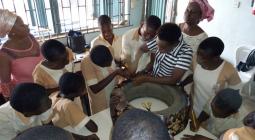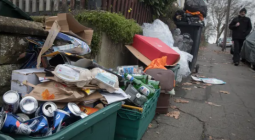How Community Cardboard Shredding in Hawaii Is Helping Residents, Businesses and the Environment

According to the U.S. Environmental Protection Agency (EPA), in 2018, paper and cardboard were the largest components of municipal solid waste in the United States with citizens throwing away a total of 67.4 million tons a year.
Around 68 percent of that was recycled, while the other 32 percent was either incinerated or left in increasingly overstuffed landfills where it releases methane as it deteriorates.
More toxic than carbon dioxide, methane is one of the leading contributors to climate change, and in 2019, the EPA recorded that methane from landfills contributes to 15.1% of overall emissions in the U.S.
In Hawaii, while some cardboard inevitably ends up in overstuffed landfills, most cardboard is packaged and sent thousands of miles to Asia due to a lack of their own recycling facilities, which, while better than the alternative, is costly and leaves a pretty hefty carbon footprint.
Because of this, some residents have taken it into their own hands to find better solutions.
Circle Pack, a mobile grassroots cardboard shredding organization located in Hawaii County (also known as the Big Island) has been stepping in with solutions that are not only sustainable for the environment, but also bring Hawaii more self-reliance, and communities together in the process.
Founded in 2020 by 29-year-old Evan Lam, the company travels to several partner organizations, where residents and area businesses drop off hundreds of pounds of clean cardboard to be shredded by community volunteers and either used for packaging or given away as mulch or composting materials for farms and gardens.
“One of the biggest responses that I see happening kind of all over the world, and here in Hawaii, is localization,” said Lam. “The more that we can do and process and take care of things at a local or regional level that’s kind of geographically bounded, the further we can get in just eliminating sources of greenhouse gas emissions.”
Lam was born and raised in Hawaii, and had long been interested in sustainability, first through his participation in high school with conservation nonprofit KUPU — which provides land stewardship and service-learning opportunities for youth — then later in San Francisco through the youth-led climate justice group the Sunrise Movement.
However, Circle Pack came out of a conversation he had with his mothers, who own a non-toxic nail polish business and do a lot of e-commerce.
At the time, they were paying a packaging company in California exorbitant shipping fees that cost more than the materials they were buying to ship their merchandise, so Lam did a little bit of research on making packaging from cardboard and bought a machine to start making materials for the family business himself.
“And then that quickly kind of moved to more,” he said, particularly after being introduced to one of his early partners, Chantal Chung, who has a larger vermicomposting operation, and was in desperate need of more brown matter to sustain it.
Chung is the co-founder of Ma’ona Community Garden in South Kona, which is not so much a garden as much as a dense haven of cultural and sustainable food systems to fill the security and health needs of the community, particularly the oft-disenfranchised Native Hawaiian community.
Besides an abundant food forest, and several garden plots where families can grow their own crops for free, Chung’s vermicomposting operation involves sixteen forty-by-four-foot worm bins she uses to process food waste from Ma’ona’s partners at Hawaii’s Ulu Cooperative, a co-op made of over 80 local farmers that among many things do e-commerce, and also farm-to-school initiatives.
Before scaling back and finding other partners to compost, at one point she was taking in a thousand pounds of food waste a day to avoid having it go to the landfill, where like cardboard, it also produces methane while decomposing, and in 2018, constituted for 21 percent of total municipal solid waste from commercial, institutional and residential sectors in the U.S. at 63.1 million tons.
Chung, whose grandparents were coffee farmers, were the ones who not only taught her about the importance of worms, which she said is the third animal mentioned in the Kumulipo (the sacred Hawaiian creation chant), but also cardboard, which her grandfather laid in the coffee fields and in between rows.
Cardboard not only helps sequester carbon in the soil, but as it decomposes, it supplies essential energy to the microbes, improving soil quality and structure and making it an easy and affordable option for those in agriculture.
Before serendipitously meeting Lam, she began hauling it in herself from various locations and shredding the cardboard by hand.
“And he [already] has the shredded paper waste,” she said. “What’s lovely about cardboard being shredded is it increases the microbial and fungal infiltration, which decreases the time for it to break down.”
Since they met, she’s established a 24/7 community cardboard dropoff, and every third Saturday of the month, she and Lam hold a shred day, where community volunteers help shred hundreds of pounds of clean cardboard from area residents and businesses.
Chung keeps around 1000 pounds for Ma’ona and shares the rest with area farmers.
“There is definitely a need in the community,” said Kiana Vallente, the administrative director at Hamakua Harvest, an agricultural hub in Waimea that hosted Circle Pack at their farmer’s market for the first time in late February.
She said a lot of people came up and asked questions, which was a nice opportunity to educate them about where their recycling usually goes and how they are trying to keep things on island. Prior to pairing up with Circle Pack, Vallente also had no idea where her cardboard was going.
“The gardeners and farmers got really excited,” she said, adding that the farmers at the market selling produce took a bunch of shredded cardboard home with them to use on their farms. “It was really awesome to see that full circle effect.”
According to Lam, at the market that day, they shredded around 350 pounds of cardboard, which he claimed was the busiest first day at a marketplace he’s ever done.
To date, Lam said that he had shredded 22,200 pounds since he began a little over a year ago, which was helpful, particularly during the pandemic when transfer stations were understaffed because of COVID-19. This left certain cardboard bins filled to capacity, without any room to take more, leading to more cardboard ending up at the landfill.
As it is, in late 2019, the county decided to stop collecting plastic and paper, citing significant decreases in global recycling markets, then later because private contractor Business Services Hawaii could no longer afford to process most plastics.
Now unless residents, local government entities, or other organizations find alternatives, most of this goes to the West Hawaii landfill, since the other landfill on the island had to permanently close in 2020, because it was packed to capacity with 3 million tons of refuse.
For a while, like Circle Pack, grassroots efforts to deal with the problem cropped up through an organization called Puna Precious Plastics, which operated under a larger international organization called Precious Plastics, but according to their social media, due to unforeseen complications and COVID-19 safety, it shut down in 2020.
Since then, others like Volcano Precious Plastics have emerged making planters and pavers out of Hi-5 plastics.
As for cardboard, Circle Pack has been offering free demos to draw in communities, but then charges a fee for their services for later bookings. The organization has also been getting some funding through Hawaii County, and the Economic Development Administration’s Build Back Better grant to continue.
“How do we take what we have and make what we need so we don’t have to look outside of Hawaii?” Chung said, adding, “The most important thing to develop these kinds of projects is not about the funding. It’s partnerships, human resources — it’s that ability to connect to each other.”
She hopes that what they’re doing will be an example for neighboring islands, where they can see how rich in resources the practice is and its potential for community-based economic development.
Lam said he doesn’t know that his goal is to recycle 100% of the cardboard locally, but that it seemed like they’d be able to cut out a large chunk of that waste stream and use it as much as they could as long as people saw value in it.
“It’s the process of kind of learning to be part of the world,” he said. “Being in the mix, as far as actual processes and politics and systems, instead of commenting from the outside,” adding that the question at the core of this is: “How do we bring our relationship with nature into better harmony?”
Author:Libby Leonard





